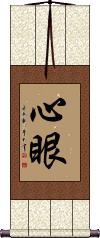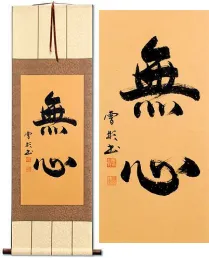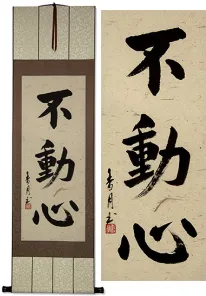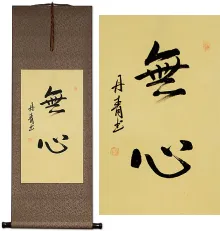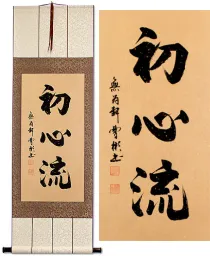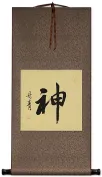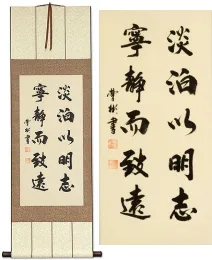Many custom options...
And formats...

Mind Eye in Chinese / Japanese...
Buy a Mind Eye calligraphy wall scroll here!
Mind’s Eye
This in-stock artwork might be what you are looking for, and ships right away...
Gallery Price: $200.00
Your Price: $118.88
Gallery Price: $200.00
Your Price: $118.88
Gallery Price: $202.00
Your Price: $111.88
Gallery Price: $79.00
Your Price: $43.88
Gallery Price: $202.00
Your Price: $111.88
Gallery Price: $198.00
Your Price: $109.88
Not the results for mind eye that you were looking for?
Below are some entries from our dictionary that may match your mind eye search...
| Characters If shown, 2nd row is Simp. Chinese |
Pronunciation Romanization |
Simple Dictionary Definition |
心眼 see styles |
xīn yǎn xin1 yan3 hsin yen shingan しんがん |
More info & calligraphy: Mind’s Eyethe mind's eye The eye of the mind, mental vision. |
境 see styles |
jìng jing4 ching sakae さかえ |
border; place; condition; boundary; circumstances; territory (1) border; boundary; (2) turning point; watershed; (3) area; region; spot; space; environment; (4) psychological state; mental state; (1) border; boundary; (2) area; region; spot; space; environment; (3) psychological state; mental state; (4) (Buddhist term) cognitive object; something perceptible by the sense organs or mind; (surname) Sakae viṣaya; artha; gocara. A region, territory, environment, surroundings, area, field, sphere, e.g. the sphere of mind, the sphere of form for the eye, of sound for the ear, etc.; any objective mental projection regarded as reality. |
識 识 see styles |
zhì zhi4 chih tsuguhide つぐひで |
to record; to write a footnote (1) acquaintanceship; (2) {Buddh} vijnana; consciousness; (3) (after a signature) written by...; (personal name) Tsuguhide vijñāna, "the art of distinguishing, or perceiving, or recognizing, discerning, understanding, comprehending, distinction, intelligence, knowledge, science, learning . . . wisdom." M.W. parijñāna, "perception, thorough knowledge," etc. M.W. It is intp. by 心 the mind, mental discernment, perception, in contrast with the object discerned; also by 了別 understanding and discrimination. There are classifications of 一識 that all things are the one mind, or are metaphysical; 二識 q. v. discriminating the ālaya-vijñāna or primal undivided condition from the mano-vijñāna or that of discrimination; 三識 in the Laṅkāvatāra Sutra, fundamental, manifested and discriminate; 五識 q.v. in the 起信論, i.e. 業, 轉, 現, 知, and 相續識; 六識 the perceptions and discernings of the six organs of sense; also of 8, 9, 10, and 11 識. The most important is the eight of the 起信論, i.e. the perceptions of the six organs of sense, eye, ear, nose, tongue, body (or touch), and mind, together with manas, intp. as 意識 the consciousness of the previous moment, on which the other six depend; the eighth is the ālaya-vijñāna, v. 阿賴耶, in which is contained the seed or stock of all phenomena and which 無沒 loses none, or nothing, is indestructible; a substitute for the seventh is ādāna 'receiving' of the 唯識, which is intp. as 無解 undiscriminated, or indefinite perception; there is a difference of view between the 相 and the 性 schools in regard to the seventh and eight 識; and the latter school add a ninth called the amala, or pure vijñāna, i.e. the non-phenomenal 眞如識. The esoterics add that all phenomena are mental and all things are the one mind, hence the one mind is 無量識 unlimited mind or knowledge, every kind of knowledge, or omniscience. vijñāna is one of the twelve nidānas.; Ālaya-vijñāna and mano-vijñāna; i. e. 阿梨耶 | and 分別事 |; v. 識. |
六入 see styles |
liù rù liu4 ru4 liu ju rokunyuu / rokunyu ろくにゅう |
{Buddh} six sense organs (eyes, ears, nose, tongue, body, and mind) ṣaḍāyatana; 六阿耶怛那 (or 六阿也怛那) the six entrances, or locations, both the organ and the sensation — eye, ear, nose, tongue, body, and mind; sight, hearing, smell, taste, touch, and perception. The six form one of the twelve nidanas, see 十二因緣. The 六根 are the six organs, the 六境 the six objects, and the 六塵 or guṇas, the six inherent qualities. The later term is 六處 q. v.; The "six entries" ṣaḍāyatana, which form one of the links in the chain of causaton, v. 十二因緣 the preceding link being觸contact, and the succeeding link 識 perception. The six are the qualities and effects of the six organs of sense producing sight, hearing, smell, taste, touch, and thought (or mental presentations). v. also 二入. |
六根 see styles |
liù gēn liu4 gen1 liu ken rokkon ろっこん |
{Buddh} six sense organs (eyes, ears, nose, tongue, body, and mind); (surname) Rokkon The six indriyas or sense-organs: eye, ear, nose, tongue, body, and mind. See also 六入, 六境, 六塵, and 六處. |
六賊 六贼 see styles |
liù zéi liu4 zei2 liu tsei rokuzoku |
The six cauras, or robbers, i. e. the six senses; the 六根 sense organs are the 媒 'matchmakers', or medial agents, of the six robbers. The 六賊 are also likened to the six pleasures of the six sense organs. Prevention is by not acting with them, i. e. the eye avoiding beauty, the ear sound, nose scent, tongue flavors, body seductions, and mind uncontrolled thoughts. |
心目 see styles |
xīn mù xin1 mu4 hsin mu shinmoku |
mind Mind and eye, the chief causes of the emotions. |
慧眼 see styles |
huì yǎn hui4 yan3 hui yen keigan / kegan けいがん |
an all-seeing mind; mental perception; insight; acumen (noun or adjectival noun) keen eye; quick eye; sharp eye; keen insight; keen perception The wisdom-eye that sees all things as unreal. |
斫芻 斫刍 see styles |
zhuó chú zhuo2 chu2 cho ch`u cho chu shashu |
(斫乞芻) cakṣu (s), the eye, one of the six organs of sense. Cakṣurdhātu is the 眼界 eye-realm, or sight-faculty. There are definitions such as the eye of body, mind, wisdom, Buddha-truth, Buddha; or human, deva, bodhisattva, dharma, and Buddha vision. |
神通 see styles |
shén tōng shen2 tong1 shen t`ung shen tung jinzuu / jinzu じんづう |
remarkable ability; magical power (place-name) Jinzuu (神通力) Ubiquitous supernatural power, especially of a Buddha, his ten powers including power to shake the earth, to issue light from his pores, extend his tongue to the Brahma-heavens effulgent with light, cause divine flowers, etc., to rain from the sky, be omnipresent, and other powers. Supernatural powers of eye, ear, body, mind, etc. |
緣緣 缘缘 see styles |
yuán yuán yuan2 yuan2 yüan yüan enen |
The reasoning mind, or the mind reasoning, intelligence in contact with its object; later termed 所緣緣, i.e. 所緣 being the object and 緣 the mind; the relationship being like that of form or colour to the eye. |
七心界 see styles |
qī xīn jiè qi1 xin1 jie4 ch`i hsin chieh chi hsin chieh shichi shinkai |
The seven realms of vijñāna, or perception, produced by eye, ear, nose, tongue, body, mind, to which is added thought, 意 根 q.v. |
胎藏界 see styles |
tāi zàng jiè tai1 zang4 jie4 t`ai tsang chieh tai tsang chieh taizō kai |
Garbhadhātu, or Garbhakośa-(dhātu), the womb treasury, the universal source from which all things are produced; the matrix; the embryo; likened to a womb in which all of a child is conceived— its body, mind, etc. It is container and content; it covers and nourishes; and is the source of all supply. It represents the 理性 fundamental nature, both material elements and pure bodhi, or wisdom in essence or purity; 理 being the garbhadhātu as fundamental wisdom, and 智 acquired wisdom or knowledge, the vajradhātu. It also represents the human heart in its innocence or pristine purity, which is considered as the source of all Buddha-pity and moral knowledge. And it indicates that from the central being in the maṇḍala, viz. the Sun as symbol of Vairocana, there issue all the other manifestations of wisdom and power, Buddhas, bodhisattvas, demons, etc. It is 本覺 original intellect, or the static intellectuality, in contrast with 始覺 intellection, the initial or dynamic intellectuality represented in the vajradhātu; hence it is the 因 cause and vajradhātu the 果 effect; though as both are a unity, the reverse may be the rule, the effect being also the cause; it is also likened to 利他 enriching others, as vajradhātu is to 自利 enriching self. Kōbō Daishi, founder of the Yoga or Shingon 眞言 School in Japan, adopted the representation of the ideas in maṇḍalas, or diagrams, as the best way of revealing the mystic doctrine to the ignorant. The garbhadhātu is the womb or treasury of all things, the universe; the 理 fundamental principle, the source; its symbols are a triangle on its base, and an open lotus as representing the sun and Vairocana. In Japan this maṇḍala is placed on the east, typifying the rising sun as source, or 理. The vajradhātu is placed west and represents 智 wisdom or knowledge as derived from 理 the underlying principle, but the two are essential one to the other, neither existing apart. The material and spiritual; wisdom-source and intelligence; essence and substance; and similar complementary ideas are thus portrayed; the garbhadhātu may be generally considered as the static and the vajradhātu as the dynamic categories, which are nevertheless a unity. The garbhadhātu is divided into 三部 three sections representing samādhi or quiescence, wisdom-store, and pity-store, or thought, knowledge, pity; one is called the Buddha-section, the others the Vajra and Lotus sections respectively; the three also typify vimokṣa, prajñā, and dharmakāya, or freedom, understanding, and spirituality. There are three heads of these sections, i. e. Vairocana, Vajrapāṇi, and Avalokiteśvara; each has a mother or source, e. g. Vairocana from Buddha's-eye; and each has a 明王 or emanation of protection against evil; also a śakti or female energy; a germ-letter, etc. The diagram of five Buddhas contains also four bodhisattvas, making nine in all, and there are altogether thirteen 大院 or great courts of various types of ideas, of varying numbers, generally spoken of as 414. Cf. 金剛界; 大日; 兩部. |
二十二根 see styles |
èr shí èr gēn er4 shi2 er4 gen1 erh shih erh ken nijūni kon |
The twenty-two roots, organs, or powers, v. 根. They are: (1) 眼根 eye, cakṣurindriya; (2) 耳 根 ear, śrotrendriya; (3) 鼻根 nose, ghrāṇendriya; (4) 舌根 tongue, jihvendriya; (5) 身根 body, kāyendriya; (6) 意根 mind, manaīndriya (the above are the 六根); (7) 女根 female organ, strīndriya; (8) 男根 male organ, puruṣendriya; (9) 命根 life, jīvitendriya; (10) 苦根 suffering (or pain), duḥkhendriya; (11) 樂根 pleasure, sukhendriya; (12) 憂根 sorrow, daurmanasyendriya; (13) 喜根 joy, saumanas-yendriya; (14) 捨根 abandoning, upekṣendriya (from 10 to 14 they are the 五受); (15) 信根 faith, śraddhendriya; (16) 精進根 zeal, vīryendriya; (17) 念根 memory, smṛtīndriya; (18) 定根 meditation, or trance, samādhīndriya; (19) 慧根 wisdom, prajñendriya (these are the 信等之五根); (20) 未知當知根 the power for learning (the Four Noble Truths) anājñātamājñāsyāmīndriya; (21) 巳知根 the power of having learned (them), ājñendriya; (22) 具知根 the power of perfect knowledge (of them), ājñātādvīndriya (these three are called the 無漏根) . |
十二因緣 十二因缘 see styles |
shí èr yīn yuán shi2 er4 yin1 yuan2 shih erh yin yüan jūni innen |
Dvādaśaṅga pratītyasamutpāda; the twelve nidānas; v. 尼 and 因; also 十二緣起; 因緣有支; 因緣率連; 因緣棘園; 因緣輪; 因緣重城; 因緣觀; 支佛觀. They are the twelve links in the chain of existence: (1) 無明avidyā, ignorance, or unenlightenment; (2) 行 saṃskāra, action, activity, conception, "dispositions," Keith; (3) 識 vijñāna, consciousness; (4) 名色 nāmarūpa, name and form; (5) 六入 ṣaḍāyatana, the six sense organs, i.e. eye, ear, nose, tongue, body, and mind; (6) 觸 sparśa, contact, touch; (7) 受 vedanā, sensation, feeling; (8) 愛 tṛṣṇā, thirst, desire, craving; (9) 取 upādāna, laying hold of, grasping; (10) 有 bhava, being, existing; (11) 生 jāti, birth; (12) 老死 jarāmaraṇa, old age, death. The "classical formula" reads "By reason of ignorance dispositions; by reason of dispositions consciousness", etc. A further application of the twelve nidānas is made in regard to their causaton of rebirth: (1) ignorance, as inherited passion from the beginningless past ; (2) karma, good and evil, of past lives; (3) conception as a form of perception; (4) nāmarūpa, or body and mind evolving (in the womb); (5) the six organs on the verge of birth; (6) childhood whose intelligence is limited to sparśa, contact or touch; (7) receptivity or budding intelligence and discrimination from 6 or 7 years; (8) thirst, desire, or love, age of puberty; (9) the urge of sensuous existence; (10) forming the substance, bhava, of future karma; (11) the completed karma ready for rebirth; (12) old age and death. The two first are associated with the previous life, the other ten with the present. The theory is equally applicable to all realms of reincarnation. The twelve links are also represented in a chart, at the centre of which are the serpent (anger), boar (ignorance, or stupidity), and dove (lust) representing the fundamental sins. Each catches the other by the tail, typifying the train of sins producing the wheel of life. In another circle the twelve links are represented as follows: (1) ignorance, a blind woman; (2) action, a potter at work, or man gathering fruit; (3) consciousness, a restless monkey; (4) name and form, a boat; (5) sense organs, a house; (6) contact, a man and woman sitting together; (7) sensation, a man pierced by an arrow; (8) desire, a man drinking wine; (9) craving, a couple in union; (10) existence through childbirth; (11) birth, a man carrying a corpse; (12) disease, old age, death, an old woman leaning on a stick. v. 十二因緣論 Pratītya-samutpāda śāstra. |
心象風景 see styles |
shinshoufuukei / shinshofuke しんしょうふうけい |
(yoji) imagined landscape; scenery in one's mind's eye |
気になる see styles |
kininaru きになる |
(exp,v5r) (1) to weigh on one's mind; to bother one; to worry about; to be concerned about; to care about; to feel uneasy; to be anxious; (exp,v5r) (2) to be interested (in); to be curious (about); to wonder (about); to catch one's eye; (exp,v5r) (3) (usu. after a verb) to feel like (doing); to feel inclined to; to bring oneself to (do) |
一千二百功德 see styles |
yī qiān èr bǎi gōng dé yi1 qian1 er4 bai3 gong1 de2 i ch`ien erh pai kung te i chien erh pai kung te issen nihyaku no kudoku |
The 1,200 merits or powers of the organs of eye, tongue, and mind predicted in the Lotus Sutra, but, generally, the merits therein predicted to all six organs. |
眼裡容不得沙子 眼里容不得沙子 see styles |
yǎn lǐ róng bu dé shā zi yan3 li3 rong2 bu5 de2 sha1 zi5 yen li jung pu te sha tzu |
can't bear having grit in one's eye (idiom); unable to put something objectionable out of one's mind; not prepared to turn a blind eye |
Variations: |
surudoi するどい |
(adjective) (1) sharp (knife, claws, etc.); pointed; (adjective) (2) sharp (pain, tone, etc.); acute; stabbing; cutting (remark, criticism, etc.); stinging; biting; fierce (attack); pointed (question, look, etc.); piercing (gaze); shrill (sound); (adjective) (3) keen (intuition, sense of smell, etc.); acute; sharp (eye, mind, etc.); astute; shrewd; discerning; penetrating (insight, question, etc.); perceptive |
心焉に在らざれば視れども見えず see styles |
kokorokokoniarazarebamiredomomiezu こころここにあらざればみれどもみえず |
(expression) (proverb) the eye is blind if the mind is absent |
The following table may be helpful for those studying Chinese or Japanese...
| Title | Characters | Romaji (Romanized Japanese) | Various forms of Romanized Chinese | |
| Mind’s Eye | 心眼 | shingan | xīn yǎn / xin1 yan3 / xin yan / xinyan | hsin yen / hsinyen |
Successful Chinese Character and Japanese Kanji calligraphy searches within the last few hours...
